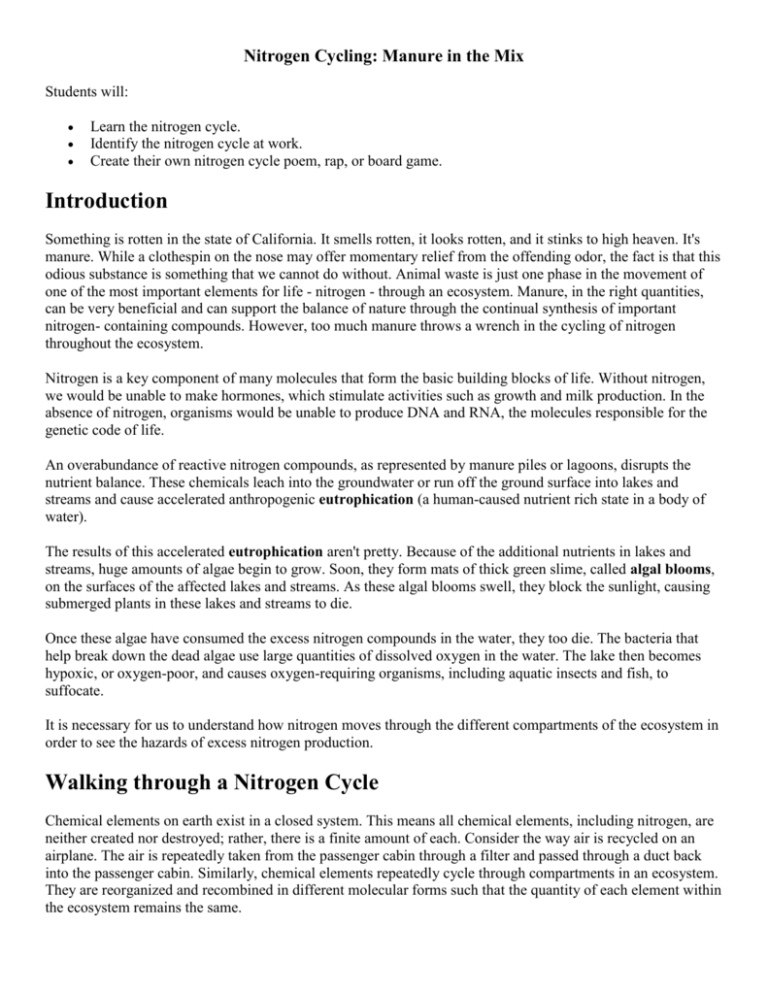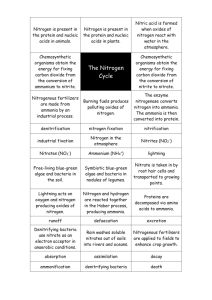Nitrogen Cycling: Manure in the Mix
advertisement

Nitrogen Cycling: Manure in the Mix Students will: Learn the nitrogen cycle. Identify the nitrogen cycle at work. Create their own nitrogen cycle poem, rap, or board game. Introduction Something is rotten in the state of California. It smells rotten, it looks rotten, and it stinks to high heaven. It's manure. While a clothespin on the nose may offer momentary relief from the offending odor, the fact is that this odious substance is something that we cannot do without. Animal waste is just one phase in the movement of one of the most important elements for life - nitrogen - through an ecosystem. Manure, in the right quantities, can be very beneficial and can support the balance of nature through the continual synthesis of important nitrogen- containing compounds. However, too much manure throws a wrench in the cycling of nitrogen throughout the ecosystem. Nitrogen is a key component of many molecules that form the basic building blocks of life. Without nitrogen, we would be unable to make hormones, which stimulate activities such as growth and milk production. In the absence of nitrogen, organisms would be unable to produce DNA and RNA, the molecules responsible for the genetic code of life. An overabundance of reactive nitrogen compounds, as represented by manure piles or lagoons, disrupts the nutrient balance. These chemicals leach into the groundwater or run off the ground surface into lakes and streams and cause accelerated anthropogenic eutrophication (a human-caused nutrient rich state in a body of water). The results of this accelerated eutrophication aren't pretty. Because of the additional nutrients in lakes and streams, huge amounts of algae begin to grow. Soon, they form mats of thick green slime, called algal blooms, on the surfaces of the affected lakes and streams. As these algal blooms swell, they block the sunlight, causing submerged plants in these lakes and streams to die. Once these algae have consumed the excess nitrogen compounds in the water, they too die. The bacteria that help break down the dead algae use large quantities of dissolved oxygen in the water. The lake then becomes hypoxic, or oxygen-poor, and causes oxygen-requiring organisms, including aquatic insects and fish, to suffocate. It is necessary for us to understand how nitrogen moves through the different compartments of the ecosystem in order to see the hazards of excess nitrogen production. Walking through a Nitrogen Cycle Chemical elements on earth exist in a closed system. This means all chemical elements, including nitrogen, are neither created nor destroyed; rather, there is a finite amount of each. Consider the way air is recycled on an airplane. The air is repeatedly taken from the passenger cabin through a filter and passed through a duct back into the passenger cabin. Similarly, chemical elements repeatedly cycle through compartments in an ecosystem. They are reorganized and recombined in different molecular forms such that the quantity of each element within the ecosystem remains the same. Now, picture yourself standing near a marsh by the bay, with channels of water extending into marsh vegetation. A flock of gulls flies overhead and drops guano, little packets of nitrogen, over the marsh plants... Ammonification: Conversion of Organic Nitrogen into Ammonia/Ammonium Much of the nitrogen contained in the guano is in the form of urea, CO(NH2)2. Urea, CO(NH2)2, quickly reacts with other compounds and ions in the atmosphere to form ammonium ions, NH4+, and ammonia, NH3. Once the poop hits the ground, bacteria and fungi continue to break it (as well as other dead organisms) down into NH4+ and NH3 through the process of ammonification. Plants can readily metabolize ammonium ions, NH4+, to build amino acids and proteins, so these ions are in high demand and quickly depleted in the soil. Nitrification: Conversion of NH3 or NH4+ into NO3Soil bacteria combine oxygen with these ammonium ions, NH4+, to form nitrite, NO2-. Another group of nitrifying bacteria converts nitrite, NO2-, into nitrate, NO3-. Negatively charged nitrates can't bind to clay particles, so they are easily leached from the soil into the groundwater. Assimilation: Plant Uptake and Use Plants may also uptake nitrate, NO3-, but must convert the nitrate back into ammonium, NH4+, in order to use the nitrogen. This is done through a process called assimilation. Nitrogen Fixation: Conversion of Nitrogen Gas Into Ammonia or Nitrate Nitrogen is made available for plants to metabolize through an additional parallel process: nitrogen fixation. Chemically inert nitrogen gas, N2, comprises 78% of the air we breathe. Both free-living and symbiotic nitrogen fixing bacteria pluck non-reactive nitrogen gas, N2, from the atmosphere and combine it with hydrogen to form ammonia, NH3. These bacteria use only the nitrogen that they require to live and then make this nitrogen available to plants when they die. Symbiotic nitrogen fixers live in nodules - the little white knobs found on the roots of legumes like clover and beans. The plants give the bacteria carbon in exchange for the excess nitrogen that the bacteria fix. In addition, nitrogen can be fixed by combustion, volcanic activity, lightning discharges, and commercial fertilizer production. The intense heat released by these processes breaks the strong bonds that bind the two nitrogen atoms together in N2. The nitrogen then combines with oxygen to form nitrate, NO3-. Denitrification: Reduction of Nitrate into Nitrogen Gas When the marsh ecosystem is oxygen deficient or the nitrates, NO3-, are in overabundance, denitrifying bacteria reduce the nitrates, NO3-, back into nitrogen gas, N2. Worksheet: Tracking the Path of Nitrogen Students will identify the components and processes of the nitrogen cycle in two ecosystems. Student Directions: In pairs, study the California oak woodland diagram at right. On a piece of paper, numbered 1 - 13. Identify the nitrogen compounds and nitrogen cycle processes represented by each of the numbered boxes at right. Each thin-lined box represents a nitrogen compound. Each thick-lined box represents a process, such as nitrification. Refer to glossary. 1. 2. 3. 4. 5. 6. 7. 8. 9. 10. 11. 12. 13. Study the lake eco-system image at right. This time there are no boxes to provide you with hints. Record your answers to the questions below. 14. Where are the sources of nitrogen gas? 15. What is facilitating nitrogen fixation? 16. What organisms in the image produce urea? 17. What organisms are responsible for converting the ammonium into nitrite and nitrate? 18. Where is assimilation occurring in this picture? 19. What processes are at work below ground in the nitrogen cycle? 20. What organisms are responsible for these processes? 21. What visual cues tell you that the nitrogen cycle is out of balance? 22. How might the image look different if it were in balance? 23. What suggestions would you make for lowering the nitrogen inputs? Glossary of Terms Ammonia: NH3 is a product of the decomposition of animal waste. It is also a toxic gas, which is present in a low concentration in household cleaning products. Ammonification: The process by which decomposers break down proteins and nucleic acids to release excess nitrogen in the form of ammonia, NH3, and ammonium ions, NH4+. Ammonium ions: NH4+ is a form of nitrogen that can bind to the surface of soil particles. Formed during ammonification. Assimilation: When a plant absorbs NO3- and coverts it to NH4+ so it can be used. Denitrification: The process by which bacteria reduce organic, chemically reactive forms of nitrogen, such as nitrite and nitrate, back into nitrogen gas. This process occurs when there are low levels of oxygen. Eutrophic: Water rich in mineral and organic nutrients that promote a proliferation of algae, which reduces the dissolved oxygen content. Hypoxic: Oxygen poor. Nitrate: NO3-, a compound that is formed when bacteria in the soil combine nitrogen with oxygen. These bacteria are different from those responsible for forming nitrites. Nitrogen in this form is very easily washed out of the soil. Nitrification: The process in which soil-dwelling bacteria oxidize ammonia, NH3, into nitrite, NO2 -, and nitrate NO3-. Nitrite: NO2-, the reduced form of nitrate. A compound that is formed when bacteria pull off an oxygen from a nitrate. Nitrogen Cycle: The abiotic and biotic pathways that nitrogen travels within an ecosystem. The cycle in which nitrogen is combined with other organic elements into various forms of reactive and non-reactive, organic and inorganic molecules, at times in the atmosphere, in an organism, or in the soil. Nitrogen fixation: The process of converting nitrogen gas, N2, into a form that organisms can use, such as ammonia, NH3, or nitrate, NO3-. Oxidation: Chemical process in which an oxygen atom is attached to an element or compound and a hydrogen atom is detached from the element or compound: net loss in negative charge. Reduction: Chemical process in which a hydrogen atom is attached to an element or compound and an oxygen atom is detached from the element or compound; net gain in positive charge.







